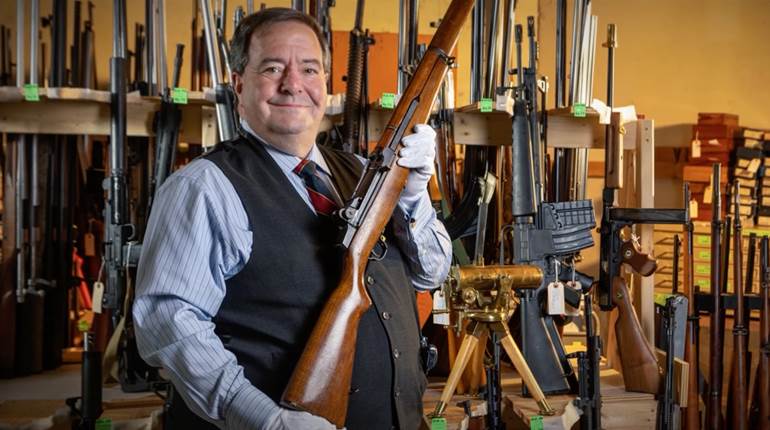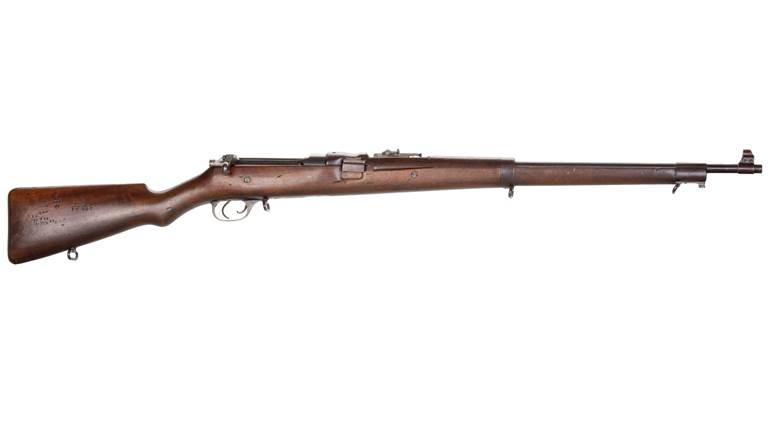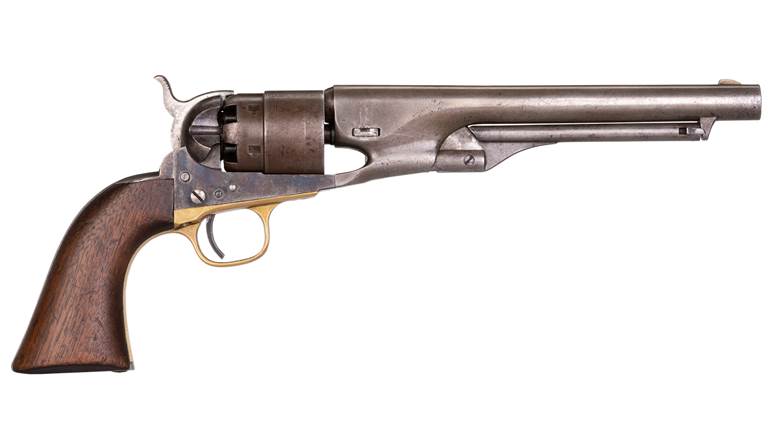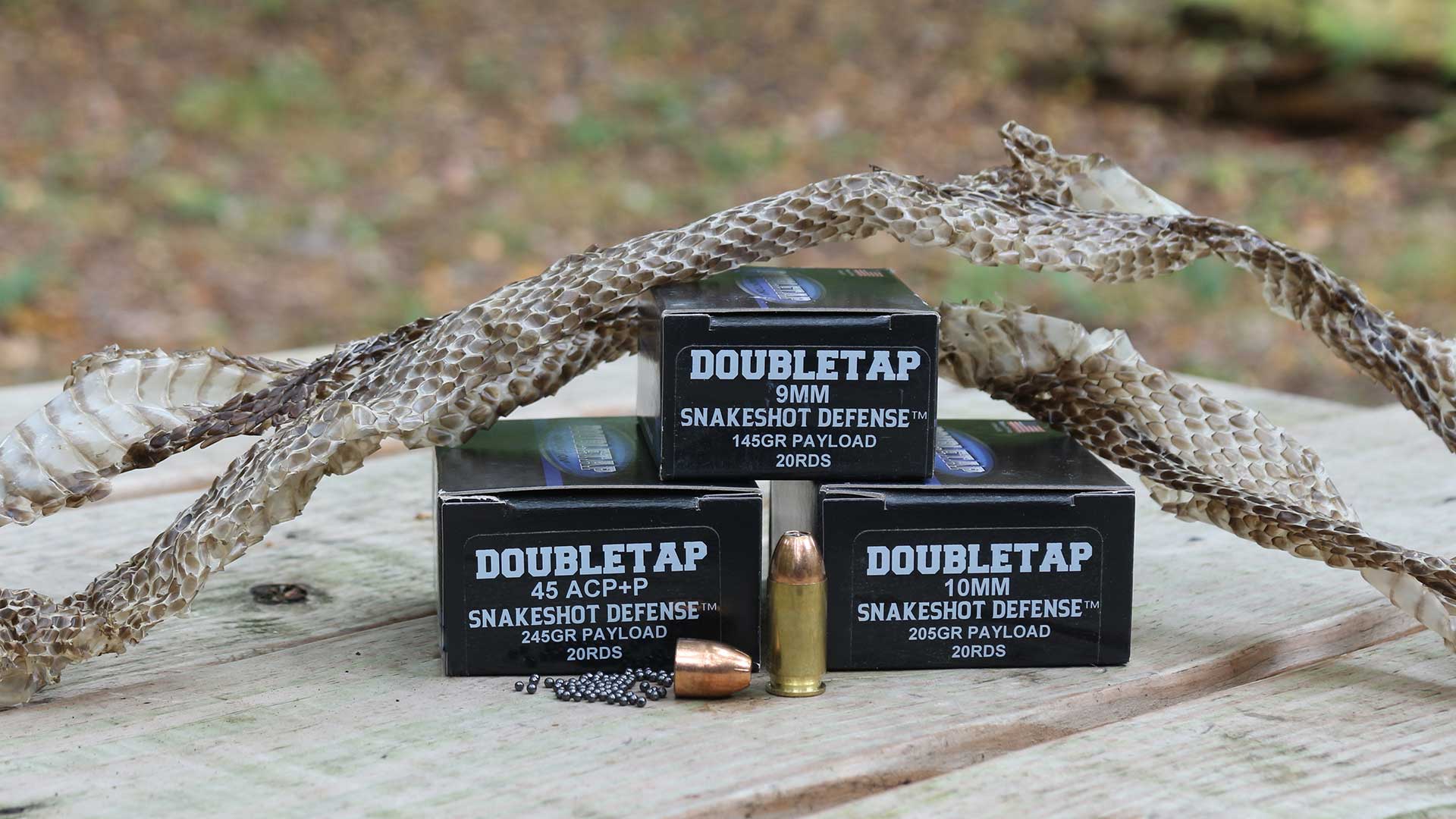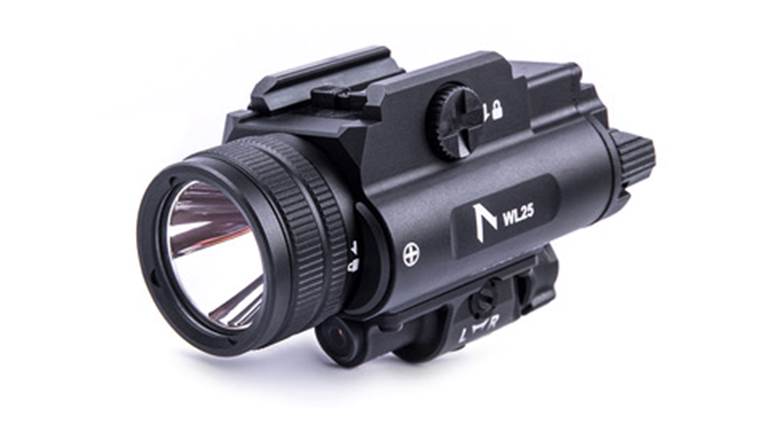
The Winchester Model 1895, serial number 23576 (top), was presented by Theodore Roosevelt to his friend and commanding officer during the Spanish-American War, Gen. Leonard Wood. As with most of all of his Winchesters, this rifle was embellished. It also has a gold plate engraved with “To Leonard Wood, Governor of Cuba, 12-29-99 from TR.” The Winchester Model 1895 in .405 Win. (bottom) was owned and used by Theodore Roosevelt, Jr.
This article was first published in American Rifleman, January 2002, under the title, "Personally, I Prefer the Winchesters." "The Winchester stocked and sighted to suit myself is by all odds the best weapon I ever had, and I now use it almost exclusively ... .”
"The Winchester stocked and sighted to suit myself is by all odds the best weapon I ever had, and I now use it almost exclusively ... .”
—Theodore Roosevelt, Hunting Trips of a Ranchman
He was a human dynamo. He was the 26th and youngest President of the United States. He was an avid hunter, a Nobel Prize winner, a wildlife conservationist, a war hero, a Life member of the National Rifle Association, the author of 39 books, a father of six and the most gun-savvy man to ever occupy The White House. When it came to gun knowledge or shooting skill, no chief executive, now or then, was his peer.
When it came to firearms he wrote a number of times that his favorite was the Winchester. From his first Winchester, a Model 1876 he ordered when he was 22 years old, to his favorite Model 1895, last used on a river exploration just scant years before his death at the age of 60, Roosevelt’s Winchesters are now legendary and priceless pieces of Americana.

Roosevelt, who was fond of exquisite goods, had within his economic means the ability to own any rifle manufactured during the period. Fine English doubles were considered the apex of the sporting world, yet Roosevelt choose an American classic or, perhaps, the rifles he chose helped make them classics. Roosevelt’s poor eyesight may have been a mitigating factor in his fondness for the arms of Oliver Winchester and his Winchester Repeating Arms Co. He was quoted as saying that he didn’t “know how to shoot well, but I know how to shoot often.”
No gun of the period shot more often or as reliably as did the Winchester—some models were capable of holding as many as 16 cartridges. Roosevelt no doubt enjoyed the capability of having plenty of ammunition in the gun as well as having a firearm that could easily bring each successive round into battery with effortless ease and remarkable reliability. To a man whose shooting skill was severely hampered by his eyesight—nearsightedness and later blindness in one eye—the fact that a Winchester could be sighted and fired, and fired again without having to remove the gun from his shoulder would have been a welcome feature for this “Bull Moose” of a man.
He special ordered his first Winchesters in the late summer of 1881, possibly to celebrate the publication of his second book, The Naval War of 1812. He ordered a pair of consecutively numbered Model 1876s, and these guns would be similar in composition to nearly every one of the next 20 Winchesters that he ordered. When he wrote “stocked and sighted to suit me,” he meant that the guns should have half-round and half octagonal barrels, pistol-grip, deluxe-checkered stocks, case hardened receivers—sometimes factory engraved—plain triggers, half-magazines, shotgun butts and special sights. Generally, enough special order features were desired by Roosevelt to cause the price of the gun to double!

In the summer of 1883, Roosevelt was hit with a bout of wanderlust that directed his daydreams to the plains of the “Wild West.” He decided to check out the Dakota Badlands along the Little Missouri River. His Winchesters caught the attention of everyone who saw them and they marveled at the exquisite nature of the engraving and checkering. William Dantz, who remembered meeting Roosevelt, was so impressed by one Winchester that he mistook it for the exceedingly rare 1 of 1,000 model (he never did own one). To those who had grown up on the Plains, Roosevelt was the epitome of an Eastern dude. Dressed in a fringed and embroidered shirt and buckskin pants with a wide-brimmed Boss-of-the-Plains Stetson, he looked the part of the hapless greenhorn that every dime novelist depicted.
Though his trip diary mentions nothing of the two deluxe Winchesters in his personal inventory, he managed in 16 days to bag one bison, a blacktail buck, assorted rabbits, grouse, teal and other such wildlife all with a Sharps .45-cal. 1874 Sporting rifle or a 10-ga. double-barreled shotgun that had been a gift from his brother Elliott. He was so impressed with his guide, Joe Ferris, and the territory he had traveled that he promptly purchased a sizeable ranch and made Ferris a foreman along with fellow guide William Merrifield.
Roosevelt returned east to run for re-election and await the expected birth of his first child who was due in mid-February of 1884. As the winter passed, the re-elected assemblyman began to plan a grizzly bear hunt for his next trip to the Badlands and purchased a second ranch called the Elkhorn, not far from his Maltese Cross ranch purchased the year before.
On Valentines Day, 1884, he received a wire while on the floor of the New York State House in Albany. He rushed home to find that his wife had delivered a healthy baby girl, named Alice Lee, after her mother. However, the heartfelt joy of a first child was quickly diminished as first his mother and then his wife both died within hours of each other. Devastated and heartbroken, he sought solace in the Badlands of the West.
Scheduled to begin his second expedition exactly one year after his first one had begun, he ordered two more Winchesters, an 1873 in .32-20 Win. and another 1876 in .45-75 Win. (the previous two had been in .50-95). Roosevelt had pretty much decided to lose himself in the Dakota Territory and make a go of being a rancher. It was possibly during this trip that Roosevelt made a present of one of those first new Winchesters he had bought in 1881. He had a special gold plate (a motif that he would use repeatedly) engraved and mounted on the butt with an inscription to William Merrifield and it carried the brand of the Maltese Cross ranch.

This time, the hunting was to provide Roosevelt’s first taste of dangerous game, a grizzly bear. During the hunt, he and Merrifield came upon the king of North American beasts. He recounted to his sister in a letter: “I shall not soon forget the first [grizzly] I killed. We had found where he had been feeding on the carcass of an elk; and followed his trail to a dense pine forest, fairly choked with fallen timber. While noiselessly and slowly threading our way through the thickest part of it, I saw Merrifield, who was directly ahead of me, sink suddenly to his knees and turn half around, his face fairly ablaze with excitement.
“Cocking my rifle and stepping quickly forward, I found myself face to face with the great bear, who was less than twenty five feet off—not eight steps. He had been roused from his sleep by our approach; he sat up in his lair, and turned his huge head slowly towards us. At that distance and in such a place it was very necessary to kill or disable him at the first fire; doubtless my face was pretty white, but the blue barrel was as steady as a rock as I glanced along it until I could see the top of the bead fairly between his two sinister looking eyes; as I pulled the trigger I jumped aside out of the smoke, to be ready if he charged; but it was needless, for the great brute was struggling in the death agony, and as you will see when I bring home his skin, the bullet hole in his skull was as exactly between his eyes … . This bear was nearly nine feet long and weighed over a thousand pounds.” The trip lasted seven weeks, the longest hunting expedition mounted by the future President until his African Safari of 1909-1910.

A review of various articles and books, most notably R. L. Wilson’s Theodore Roosevelt—Outdoorsman confirm that he had at least 20 Winchester rifles in his collection. By far, it was the gun for Roosevelt. When it came to presenting a gift to an admired associate or hunting companion, Roosevelt was quick to share his affection for Winchesters with those he honored by his generosity. The Metcalf brothers who had provided the president with a bear hunt in 1902—a hunt that begat the legend of the Teddy Bear—were each presented with identical Model 1886s exactly like the president’s own. Another 1886 was a gift to a man named Holt Collier.
Possibly one of the finest and most historic gifts made by Roosevelt was a Winchester Model 1895, serial number 23576. As with most of all of his Winchesters, this rifle was embellished with a gold plate and was inscribed “To Leonard Wood, Governor of Cuba, 12-29-99 from TR.” At the time of the rifle’s presentation, Roosevelt was governor of New York and Gen. Wood had just accepted the stewardship of the island of Cuba as her governor. Wood was a career army officer and Medal of Honor winner who, in May of 1898, had accepted command of the 1st U.S. Volunteer Cavalry and was somewhat chagrined to find that his second in command was the former assistant secretary of the Navy, Theodore Roosevelt. However, during training in San Antonio and in combat in Cuba, Roosevelt proved himself to be an efficient soldier and inspiring leader. Wood felt confident, when he was called to accept a promotion at the divisional level, that Roosevelt could handle the command of the unit that was now affectionately know as “Roosevelt’s Rough Riders” by the press.
By nightfall of July 1, 1898, Roosevelt had led his men directly into the pages of the history books with their gallant charge up Kettle and San Juan Hills. Roosevelt’s charge won him a place on McKinley’s re-election ticket as vice president, as well as the Medal of Honor. (He was recommended for it in 1898, but due to politics it was denied him. The medal was finally awarded posthumously on January 16, 2001.) He gave his former commander an exquisite 1895 rifle as a token of his esteem when both men were governors.

Whenever Winchester introduced a new model, Roosevelt was quick to put it through its paces. He acquired an 1894 similar to all his other rifles in extras and embellishments and used it on an antelope hunt. His “little .30” as he called it, was able to knock down a good sized antelope at a distance of more than 180 yds. After witnessing the fantastic shot and the irrefutable and immediate results, his guide said that the gun was just “aces” in his book! He also used a Model 94 outfitted with a Maxim silencer at his Long Island home “Sagamore Hill” so as not to disturb neighbors when varmints were in need of culling.
Roosevelt’s deeds with his Winchesters are certainly the stuff of legend. You could hardly be expected to find a more colorful figure so strongly linked to something that is now, and in no small measure due to his patronage, considered a household word and so instantly recognizable. Once, while on a hunting trip, he led in the capture of three riverboat thieves with an 1876 Winchester at the ready. Another time while riding the perimeter of his ranch, he was set upon by a band of restless Sioux. One clear view of his Winchester across the saddle and they soon scattered. He would have been photographed holding a Winchester 1895 carbine atop San Juan Hill during the Spanish-American War had he not given it to another trooper in his unit who was without a rifle at the time.
A prolific writer, he authored hundreds of magazine articles and 39 books, six of which were about his hunting adventures. When it came to Winchesters he heaped praise upon them generously. His biggest and best publicized hunting expedition was the one he made to Africa with son Kermit in 1909-1910. Prior to the public announcement of his trip, Roosevelt’s personal secretary, William Loeb, sent the following letter to Winchester:
“To: The Winchester Repeating Arms Company
From: William Loeb, Jr. Secretary to the President.
Date: July 16, 1908
Gentlemen:
The president is going to Africa ... .He probably has all the rifles he needs but his son has not. Before deciding what he will buy, the president would like to see your catalog ... Will you send your catalog to the President at Oyster Bay ... ?
Signed: Loeb”

Such a simple letter started a chain of events that resulted in dozens of exchanges via wire and mail over the next year concerning the rifles and equipment needed for the great expedition to Africa. Far from just wanting a few rifles for Kermit to have along on the safari, Roosevelt ended up having 15 wooden crates full of Winchester rifles, ammunition and spare parts for his expedition shipped by Winchester to his waiting steamer. Of the rifles, he choose the 1895 lever-action in .30-’03 U.S. as well as in .405 Win. to be the highlighted arms of the trip.
The 1895 Winchester was a departure from his standard taste in rifles. Designed by John Browning, the 1895 was the first Winchester to accept the new smokeless “hi-powered” rounds that were now revolutionizing the shooting world. With a tubular magazine being not only impracticable but dangerous as well when loaded with pointed bullets, Browning developed a rifle action with a box magazine that still allowed the user to get off quick successive shots that would hit harder and farther away with the new “hi-power” rounds. Roosevelt had seen the awesome effect smokeless cartridges had on battlefield tactics in Cuba in 1898 when his men were subject to withering fire from the new Spanish Mausers that used the smokeless powder. For Roosevelt, the combination of the fast working lever-action and the power the new sporting cartridges packed made the 1895 the perfect rifle.
Introduced in 1904, the .405 Win. cartridge was the most powerful round ever developed for a Winchester lever-action rifle. Roosevelt had to have not one, not two, but three 1895s in .405, and it proved very effective on almost every sort of game in Africa. The big 300-gr. bullet was a hard hitter with an initial muzzle velocity of more than 2230 f.p.s.
In perhaps the best presidential endorsement of any product ever, Roosevelt wrote in Scribners Magazine: “The Winchester .405 is, at least for me personally, the medicine gun for lions.” He created a sensation for the gun that lasts to this day. The .405 was discontinued in 1932. However, rifles chambered in “Teddy’s” caliber continue to bring a high premium over examples that are chambered in a round still readily available. In 2000, Winchester announced the re-introduction of the Browning 1895 in .405 caliber, demonstrating that the spirit of “Big Medicine” is still alive and well.
To Winchester enthusiasts, and to all gun and hunting devotees, Roosevelt will forever be a heroic figure—the perfect example of the responsible hunter, sportsman and shooter. He was an authentic statesman who knew, understood and loved firearms. He comprehended what firearms represent not only to a free society, but to the future of conservation and the sustained use of natural resources.
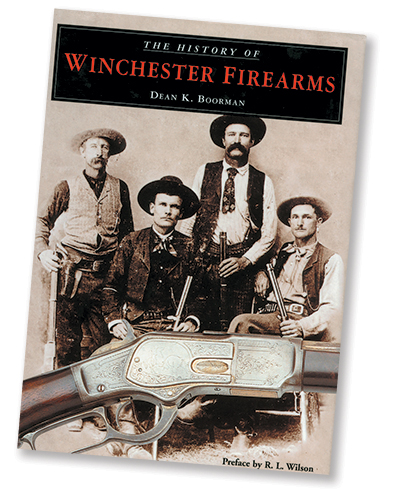
The History Of Winchester Firearms
Winchester is one of the greatest names in firearms, and in his new book, The History of Winchester Firearms, author Dean Boorman tells the story of the guns bearing the Winchester name from the Model 1866 up to the current offerings of the U.S. Repeating Arms Co. Of particular interest is the informative chapter on the development of lever-action arms, including the designs of the Volcanic Repeating Arms Co. and the Henry rifles of the New Haven Arms Co., which were the forerunners of the lever-action rifles so familiar to us today. Chapters cover the military and sporting arms of Winchester, with detailed coverage of the lever-action rifles that are the hallmark of the firm. Other chapters deal with collecting Winchesters, and emphasis is given to the many high-grade and engraved guns produced by the company.
One of the book’s chapters, “The Winchester Rifles of Theodore Roosevelt,” is the basis for the accompanying article written by Phil Schreier, curator of educational programs for the National Firearms Museum in Fairfax, Va. The 81⁄2"x11", 128-pp. book is well written and lavishly illustrated with hundreds of images. Autographed copies of The History of Winchester Firearms, along with its companion work, The History of Colt Firearms also by Boorman, may be ordered from: Dean K. Boorman, No. 40 Edgewater Road, Montclair, NJ. 07042. The price is $29.95 postpaid for each book, and the if you mention American Rifleman, the author will donate a portion of the proceeds from each book to benefit The NRA Foundation.
—Mark A. Keefe, IV













